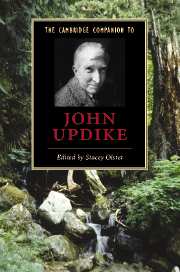Book contents
- Frontmatter
- Introduction: “A sort of helplessly 50’s guy”
- Part I Early influences and recurrent concerns
- Part II Controversy and difference
- 4 Updike, women, and mythologized sexuality
- 5 Updike, race, and the postcolonial project
- 6 Updike, ethnicity, and Jewish-American drag
- Part III American chronicles
- Conclusion: U(pdike) & P(ostmodernism)
- Select bibliography
- Index
5 - Updike, race, and the postcolonial project
from Part II - Controversy and difference
Published online by Cambridge University Press: 28 August 2006
- Frontmatter
- Introduction: “A sort of helplessly 50’s guy”
- Part I Early influences and recurrent concerns
- Part II Controversy and difference
- 4 Updike, women, and mythologized sexuality
- 5 Updike, race, and the postcolonial project
- 6 Updike, ethnicity, and Jewish-American drag
- Part III American chronicles
- Conclusion: U(pdike) & P(ostmodernism)
- Select bibliography
- Index
Summary
In his oeuvre fundamentally about middle America, what Updike has to say about race concerns white America and its constructions particularly of African Americans. As Brian Niro has pointed out, race is an “American fixation,” and “slavery has forged the concept of race in the United States into an almost exclusively black and white dynamic.” Since then, “America has consistently worked to polarize racial discourse.” Slaves are a founding presence of the nation. In order to free itself of the British Empire, to become a postcolony, America needed to have a sense of the opposite of freedom. Carrying the concept across from history, Toni Morrison has argued that American literature has been established through mirror-image binaries. Blackness has served as a “persona [performing] duties of exorcism and reification and mirroring.” This manicheanism - an opposition between light and dark of almost divine dimension - has been not only conscious but unconscious. From the short stories - “A Gift from the City” (1958; Same, 163-192) and “The Doctor's Wife” (1961; Pigeon, 197-210) - to the novel Rabbit Redux, in Updike blackness stands as other, love or hatred, guilt or fear, a measure of white American consciousness. Updike shows the myths and ideology that nevertheless make a nation's reality. Even when outside of the United States and dealing with postcolonial countries, as in The Coup and Brazil, the mirror relation obtains, this time held up to America as nation. These novels are illuminating less of Africa and Brazil than of America's ideals and failures. Inside a racial unconscious Updike has replicated otherness but also fictionalized solidarity. His works show the divide but also create surprising, generative encounters. His interest in race spans American history to a future vision, especially of America's place in the globe. It continues to his latest fiction and, in his memoir Self-Consciousness, to his intimate self.
- Type
- Chapter
- Information
- The Cambridge Companion to John Updike , pp. 76 - 90Publisher: Cambridge University PressPrint publication year: 2006
- 4
- Cited by

